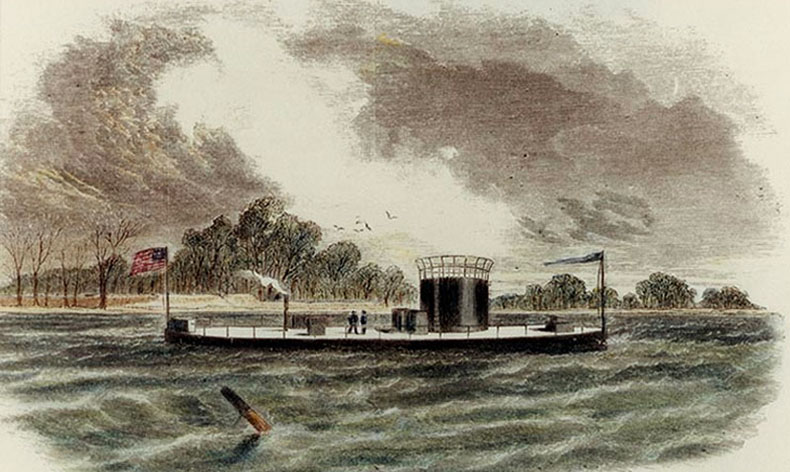
Pressures on the Sanctuary
Numerous human activities and natural events and processes affect the condition of natural and archaeological resources in marine sanctuaries. This section describes the nature and extent of the most prominent pressures on the Monitor sanctuary.
Recreational Fishing and Marine Debris
Recreational fishing may be a potential stressor to marine species and artifacts at the site of the Monitor. The structure of the wreck is very fragile and any assault, including anchoring and use of bottom fishing gear, could cause considerable damage.Due to its location in the Gulf Stream, the Monitor sanctuary is a popular destination for recreational fishing. Many charter boat captains take their clients to fish within sanctuary borders. Live boat fishing is allowed within the sanctuary, however, regulations restrict drifting without the boat motor running or anchoring. Recreational fishing is targeted at species such as black seabass (Centropristis striata), bank seabass (Centropristis ocyurus), groupers (Epinephelus andMycteroperca), snappers (Lutjanus and Rhomboplites), grunts (Haemulon) and many others.
Between 1987 and 1990, patterns of accelerated deterioration were noted along the remaining segments of the lower hull, and sections of the midship’s bulkhead collapsed. This damage has been attributed to natural deterioration as well as human activities.
In 1991, a private fishing vessel was cited by the U.S. Coast Guard for illegally anchoring in the sanctuary. Evidence documented by NOAA strongly suggested that this anchoring incident resulted in the skeg and propeller shaft dislocation, pulling it to starboard and down, ripping it loose from the lower hull and exposing the aft end of the engine room. In an effort to relieve stresses on the stern, the propeller and 11 feet of shaft were recovered in 1998.
Within the past few years, the biggest concern among the sanctuary’s staff has been marine debris, particularly the possibility of commercial fishing gear striking the wreck. Other concerns include the dumping of soda cans, beer cans and leftover food in the sanctuary. Leftover food, such as chicken bones, presents a particular threat to archaeological research because it could be recovered and mistakenly treated as a part of the Monitor’s pantry supplies. (Dixon 1990, Cuffey 1982)
Commercial Fishing
There have been incidents involving commercial fishing activity within the sanctuary that have caused serious damage to the sanctuary’s living and archaeological resources. In addition to the 1991 anchoring incident mentioned above, increasing quantities of commercial and sport fishing gear are being found in the sanctuary. In 1997, commercial fishing gear was found tangled on theMonitor. Also, during a 2004 NOAA and U.S. Navy expedition to the site, divers identified damage to the hull of the wreck and observed remains of a trawling net and long lines. However, because damage may have occurred due to the recent passing of a hurricane, no criminal charges were pursued.Diving and Artifact Recovery
The development of underwater technologies now affords the public the opportunity to locate and visit deep-water archaeological resources in the offshore environment. As diving technology advances the threat of site looting has become an increasing concern. Site looting (where objects are intentionally pilfered from submerged sites) poses a major threat to submerged archaeological resources. Divers visiting sites may cause injury through poor diving techniques, inadvertently holding onto fragile artifacts or striking them with dive gear. To address this concern, the National Marine Sanctuary Program has developed a permitting system to allow divers access to the site while ensuring continued protection of the resource by placing a sanctuary observer aboard. Permits can be obtained by applying through the Monitor sanctuary offices.Research
General research goals for the sanctuary include archaeological artifact recovery, dissemination of historical and cultural information preserved at the site, and the continued scientific study of the Monitor as an artificial reef. Research activities themselves can cause damage and potentially accelerate deterioration of the site, so there is careful review and monitoring of both public- and private-sponsored research activities in order to ensure that the site is protected and preserved. Archaeological investigation, recovery efforts and excavation conducted on theMonitor between 1998-2002 have exposed wood and metals to the environment, which has lead to increased deterioration. The impacts of the recovery efforts to the integrity of the wreck are described later in the report..Natural Deterioration
Strong currents, high water temperatures and high-salinity water in MonitorNational Marine Sanctuary have a major effect on the sanctuary’s living and non-living resources. Since its discovery, the wreck has suffered significant, ongoing deterioration in almost every portion of its hull, with the most extensive damage occurring in the stern.Additionally, hurricanes present a significant threat to the sanctuary resources. In 2003, Hurricane Isabel passed through the Monitor sanctuary, with its eye located only three-quarters of a mile from the actual Monitor site, dislodging bottom plating and disrupting the galley area. These environmental stressors accelerate deterioration of the wreck of the Monitor.

